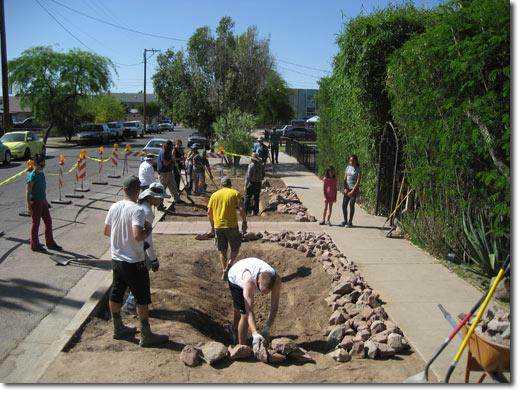




To understand permaculture is simply to look at how nature has been growing things for thousands of years. The 'secret' is simply to keep the soil covered with plants or mulch.





My project thread
Agriculture collects solar energy two-dimensionally; but silviculture collects it three dimensionally.
 3
3




Subtropical desert (Köppen: BWh)
Elevation: 1090 ft Annual rainfall: 7"




![Filename: 2014-05-17-18.25.07-w.jpg
Description: [Thumbnail for 2014-05-17-18.25.07-w.jpg]](/t/36143/a/17122/2014-05-17-18.25.07-w.jpg)
![Filename: 2014-05-17-12.50.24-w.jpg
Description: [Thumbnail for 2014-05-17-12.50.24-w.jpg]](/t/36143/a/17123/2014-05-17-12.50.24-w.jpg)
To understand permaculture is simply to look at how nature has been growing things for thousands of years. The 'secret' is simply to keep the soil covered with plants or mulch.
 1
1




Michael Vormwald wrote:Ah...so the contour is only if the slope changes. For example, if I was on top of a hill that had a north facing slope, but also sloped around to the east, the swale would contour around to stay perpendicular to the changing slope. On the other hand, if I simply had a north facing slope (and I do btw), I might have a swale that simply trenched east-west.

Michael Vormwald wrote:Hmm here's an interesting one...I just made the raised bed/mounds for my vegetable garden. This is a very slight north facing slope with the beds running east to west. So my walk ways are sortof all mini swales...
Prolly what I should do is create a 'real swale' on the south (uphill) end of the garden to better hydrate the garden???
Subtropical desert (Köppen: BWh)
Elevation: 1090 ft Annual rainfall: 7"
 2
2




How permies.com works
What is a Mother Tree ?
 1
1




Michael Vormwald wrote:So my walk ways are sortof all mini swales...
My project thread
Agriculture collects solar energy two-dimensionally; but silviculture collects it three dimensionally.




To understand permaculture is simply to look at how nature has been growing things for thousands of years. The 'secret' is simply to keep the soil covered with plants or mulch.




Cj Verde wrote:
Michael Vormwald wrote:So my walk ways are sortof all mini swales...
The walkways should be mini-swales, catching the water so it doesn't flow away from the garden.
To understand permaculture is simply to look at how nature has been growing things for thousands of years. The 'secret' is simply to keep the soil covered with plants or mulch.
 1
1




Michael Vormwald wrote:
Actually, my garden is pretty much at the top of the hill here and I think the slope is not really great enough to merit a swale...just as I think a swale has no value on flat land.
My project thread
Agriculture collects solar energy two-dimensionally; but silviculture collects it three dimensionally.
 3
3




Michael Vormwald wrote:Actually, my garden is pretty much at the top of the hill here and I think the slope is not really great enough to merit a swale...just as I think a swale has no value on flat land.


Subtropical desert (Köppen: BWh)
Elevation: 1090 ft Annual rainfall: 7"
 1
1




Subtropical desert (Köppen: BWh)
Elevation: 1090 ft Annual rainfall: 7"




Jennifer Wadsworth wrote:This blog does a nice job of describing and illustrating swales: http://www.tenthacrefarm.com/2014/02/using-swales-in-the-landscape-part-2/
To understand permaculture is simply to look at how nature has been growing things for thousands of years. The 'secret' is simply to keep the soil covered with plants or mulch.
 2
2




Subtropical desert (Köppen: BWh)
Elevation: 1090 ft Annual rainfall: 7"
 2
2




Zone 5/6
Annual rainfall: 40 inches / 1016 mm
Kansas City area discussion going on here: https://www.facebook.com/groups/1707573296152799/
 2
2




Michael Vormwald wrote:
Exactly as I have stated... a swale is used on slopes to slow water that would otherwise run off and be lost and allow it to perk into the soil.
http://www.cloud9farms.com/ - Southern Colorado - Zone 5 (-19*f) - 5300ft elevation - 12in rainfall plus irrigation rights
Dairy cows, "hair" sheep, Kune Kune pigs, chickens, guineas and turkeys
 4
4




"Turn your face to the sun and the shadows fall behind you." ~Maori Proverb
www.permi-eden.com




To understand permaculture is simply to look at how nature has been growing things for thousands of years. The 'secret' is simply to keep the soil covered with plants or mulch.
 3
3




Jaan Designs-http://www.jaandesigns.ca
Raindrop harvesting-http://raindropharvesting.ca
 2
2




 and that it is up to you what you choose and what exact purpose your swales are suppose to serve.
and that it is up to you what you choose and what exact purpose your swales are suppose to serve.Gert in the making




To understand permaculture is simply to look at how nature has been growing things for thousands of years. The 'secret' is simply to keep the soil covered with plants or mulch.
 2
2




Jaan Designs-http://www.jaandesigns.ca
Raindrop harvesting-http://raindropharvesting.ca




Michael Vormwald wrote: I have a section of land with a north facing slope that would require a swale with very little (if any) actual contour (curve) in order to maintain a level bottom.
My project thread
Agriculture collects solar energy two-dimensionally; but silviculture collects it three dimensionally.
 1
1




 1
1




Jaan Designs-http://www.jaandesigns.ca
Raindrop harvesting-http://raindropharvesting.ca




Gert in the making




To understand permaculture is simply to look at how nature has been growing things for thousands of years. The 'secret' is simply to keep the soil covered with plants or mulch.




My project thread
Agriculture collects solar energy two-dimensionally; but silviculture collects it three dimensionally.




Jaan Designs-http://www.jaandesigns.ca
Raindrop harvesting-http://raindropharvesting.ca




Earthworks are the skeleton; the plants and animals flesh out the design.

 2
2





 .
.How Permies works: https://permies.com/wiki/34193/permies-works-links-threads
My projects on Skye: The tree field, Growing and landracing, perennial polycultures, "Don't dream it - be it! "








